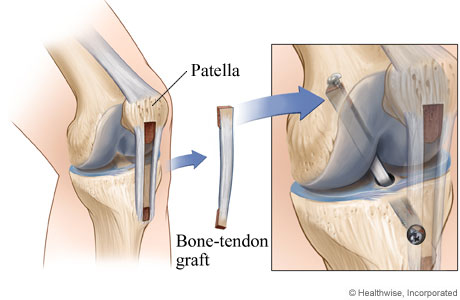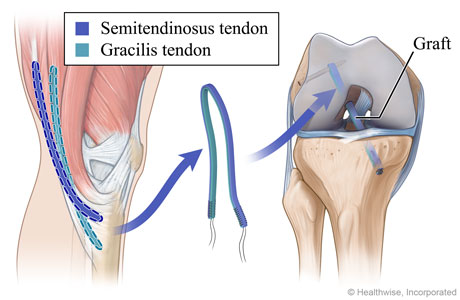Anterior Cruciate Ligament (ACL) Surgery
Surgery Overview
Surgery for anterior cruciate ligament (ACL) injuries can help you stabilize your knee and return to activity. You may have:
- Reconstruction surgery. With this, the surgeon replaces the damaged ACL with a graft. For an autograft, the surgeon uses tendon tissue from your own body. This can be done safely. Often, part of the patellar tendon at the front of the knee, or one or two of the hamstring tendons, is used for the autograft. Sometimes part of the quadriceps tendon is used. For an allograft, the surgeon uses tendon tissue from a deceased donor.
- Repair surgery. This usually is used only when the damaged ACL pulls a piece of bone off. This is called an avulsion fracture. The surgeon may reconnect the bone fragment to the area it was pulled from.
ACL surgery is usually done through arthroscopic surgery. This means your doctor will put a lighted tube with a tiny camera—called an arthroscope, or scope—and surgical tools through small incisions in your knee. Sometimes surgery is done through a larger cut in the knee. This is called open surgery.
In reconstruction of a partial or complete tear of the ACL, the best time for surgery is not known. Surgery that's done right away after the injury has been linked with increased fibrous tissue leading to loss of motion (arthrofibrosis) after surgery.footnote 1 Some experts believe that surgery should be delayed until the swelling goes down, you have regained range of motion in your knee, and you can strongly contract (flex) the muscles in the front of your thigh (quadriceps).footnote 1 Many experts recommend starting exercises to increase range of motion and regain strength shortly after the injury.
In adults, age isn't a factor in surgery, but your overall health may be. Surgery may not be the best treatment for people with medical conditions that make surgery a greater risk. These people may choose nonsurgical treatments. And they may try to change their activity levels to protect their knees from further injury.
Surgery is done under regional (such as spinal) anesthesia or general anesthesia.
How It Is Done
Bone and knee tissue graft

For anterior cruciate ligament (ACL) surgery, the replacement graft can be harvested from tissue in the patellar (kneecap) region. The surgeon removes the tissue along with a small piece of bone called a "bone block" at each end. The graft is first pulled through the two tunnels that were drilled in the upper and lower leg bones and then secured with screws or staples.
Hamstring graft

For anterior cruciate ligament (ACL) surgery, the replacement graft can be harvested from up to three tendons. The surgeon uses part of the tendon from the semitendinosus muscle and part of the tendon from the gracilis muscle. The graft is pulled through tunnels that were drilled in the upper and lower leg bones. Then the graft is secured with screws or staples.
What To Expect
Arthroscopic surgery is often done on an outpatient basis. This means that you don't spend a night in the hospital. Other surgery may require staying in the hospital for a couple of days.
You will feel tired for several days. Your knee will be swollen. And you may have numbness around the cut (incision) on your knee. Your ankle and shin may be bruised or swollen. You can put ice on the area to reduce swelling. Most of this will go away in a few days. You should soon start seeing improvement in your knee.
To care for your incision while it heals, you need to keep it clean and dry and watch for signs of infection.
Physical rehabilitation after ACL surgery may take several months to a year. How long it takes to return to normal activities or sports is different for every person. Your doctor will work with you to help you safely get back to being active again.
Why It Is Done
The goal of ACL surgery is to:
- Restore normal or almost normal stability in the knee.
- Restore the level of function you had before the knee injury.
- Limit loss of function in the knee.
- Prevent injury or degeneration to other parts of the knee.
Learn more
How Well It Works
Most people who have ACL surgery have reduced pain, good knee stability, and a return to normal activities. But some still have knee pain and instability. A few people may need another surgery (revision ACL reconstruction). Revision ACL reconstruction is generally not as successful as the initial ACL reconstruction.
Risks
ACL reconstruction surgery is generally safe, but all surgery has risks.
- Problems that can happen during or soon after surgery include:
- Infection.
- Damage to the nerves around the knee. This could cause numbness or difficulty moving the leg.
- A blood clot in the leg. Sometimes this can travel from the leg to the lung and cause a serious problem.
- Unexpected bleeding.
- The usual risks of anesthesia.
- Problems that can happen later include:
- Scarring in the knee. This may make movement difficult.
- Pain in the front of the knee.
- Loss of full range of motion in the knee.
- A failure of the graft. This may cause the knee to be unstable. This may be from reinjury or loosening of the graft.
Credits
Current as of: July 31, 2024
Author: Ignite Healthwise, LLC Staff
Clinical Review Board
All Ignite Healthwise, LLC education is reviewed by a team that includes physicians, nurses, advanced practitioners, registered dieticians, and other healthcare professionals.
Current as of: July 31, 2024
Author: Ignite Healthwise, LLC Staff
Clinical Review Board
All Ignite Healthwise, LLC education is reviewed by a team that includes physicians, nurses, advanced practitioners, registered dieticians, and other healthcare professionals.


